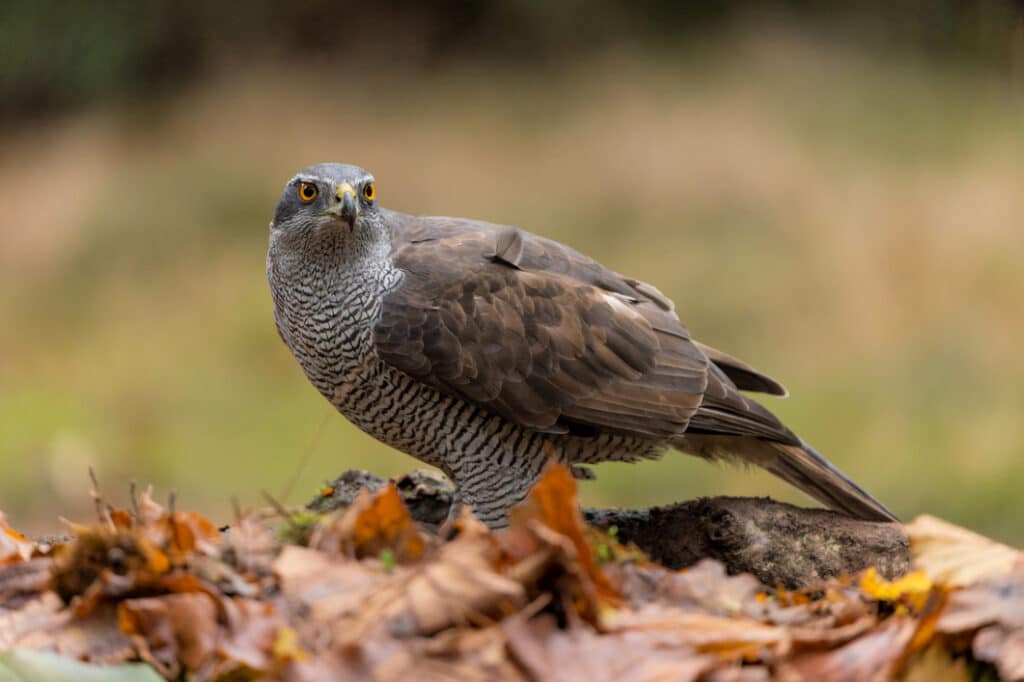Facts about the Goshawk
Scientific name: Accipiter gentilis
Bird Family: Kites, hawks, and eagles
UK conservation status: Green
At a glance
- Very scarce in Britain, females are the size of Buzzards.
- Breeds in large numbers in some European cities where they prey on pigeons and squirrels.
- Still widely persecuted on shooting estates here in the UK.

With females almost the same size as the Common Buzzard (Buteo buteo), the Eurasian Goshawk (or ‘the goshawk’) is a large, powerful hawk typically found in forests or along forest edges where they hunt other birds (such as wood pigeons and corvids) and mammals including squirrels and rabbits.
Goshawks are very rare in the UK but in some European cities, like Amsterdam, Brussels, and Prague, there are large numbers of goshawks. Berlin has the highest density of goshawk territories anywhere in the world, happily coexisting with humans. Their prey – grey squirrels and feral pigeons are their main choice – is numerous in these urban settings.
In fact, goshawks naturally help control these prey populations, something that ‘conservationists’ that shoot Grey Squirrels to boost Red Squirrel numbers might be advised to take heed of.

From celebrated to nearly wiped out.
Goshawks were once a celebrated species here, highly regarded as a hunting hawk. However, as the large-scale clearance of woodlands took place across Britain and guns replaced falconry, the goshawk was pushed into a sharp decline. With the advent of what became the shooting industry, its days here were numbered because goshawks can also take large numbers of pheasants, particularly where they’re in abundance on shooting estates.
Before their persecution began in earnest, it is estimated that 14,000 pairs of goshawks lived throughout the UK. They were extinct in England, Wales and Ireland by the mid-19th century. The last breeding record in Scotland was probably in 1883.
Goshawks have retuned to the UK now, but why?
There are now around 600 pairs of goshawks scattered across the UK, with the largest numbers in Wales and southern Scotland.
Their return has nothing whatosever to do with the benevolence of shooting estates (as shooting lobbyists have implied in the past).
There were occasional records and passage observations throughout the twentieth century (and a few isolated breeding attempts which usually ended when nesting females were shot), but while there was no official reintroduction programme, falconry escapes and deliberate releases are believed to have formed the core of what has now become a small breeding population.
Still being widely persecuted.
The goshawk population estimate we gave above may be on the low side, as some observers won’t submit nesting records in case the birds are persecuted. and they’re right to be cautious. Illegal persecution by gamekeepers is still all too common.
- A head keeper employed on a grouse moor in Royal Deeside was banned from controlling birds for three years over an alleged incident involving a goshawk in 2014.
- In 2015 George Mutch became the first gamekeeper in Scotland to be jailed for recklessly killing or injuring a goshawk and illegally taking away another goshawk and a buzzard.
- In 2020 three gamekeepers were suspended for killing a goshawk on the Duchy of Lancaster’s Goathland Moor shooting estate.
- In 2021 a highly experienced gamekeeper in the Scottish Borders was convicted after a goshawk (and a Barn Owl) died inside a trap which he’d neglected to check.
- In May 2022 the Hunt Investigation Team filmed a masked man removing a goshawk from an illegally-set trap (baited with live pigeons) on Norfolk’s Hillsborough Estate.
- In June 2022 Gloucestershire Police appealed for info after a goshawk was found shot in the Forest of Dean.
In January 2023 Suffolk Police’s Rural, Wildlife & Heritage Unit posted a request for information after the discovery of the bodies of five young goshawks dumped in Forestry England’s King’s Forest near Thetford in Suffolk.
